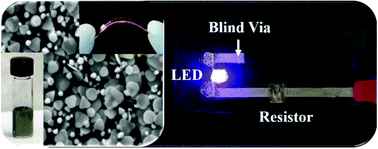Robust Ag nanoplate ink for flexible electronics packaging†
Abstract
Nanoinks are currently a topic of heightened interest with respect to low temperature bonding processes and printable electronics. We have developed an innovative polyvinylpyrrolidone (PVP)-stabilized Ag nanoplate ink amenable to very strong low temperature packaging, and investigated the relationship between bonding strength and electrical conductivity post-bonding. PVP shell plastic deformations observed in failure microcracks with the formation of PVP nanofibers, revealed bonding strength at low temperatures (<250 °C) was primarily due to adhesive bonding. It is found that, utilizing photonic sintering, ∼70 °C reduction of transformation temperature from adhesive to metallic bonding was achieved compared to that of thermal sintering. A numerical simulation was developed to better understand the influences of the light-induced heat generation, which demonstrated near-infrared light can facilitate sintering. Bonding strengths of 27 MPa were achieved at room temperatures, and 29.4 MPa at 210 °C with photonic sintering. Moreover, the anisotropic resistivity was observed with different thermal dependences. These results demonstrate Ag nanoplate inks have potential for low temperature 3D interconnections in lead-free microcircuits, flexible electronic packaging, and diverse sensing applications.


 Please wait while we load your content...
Please wait while we load your content...